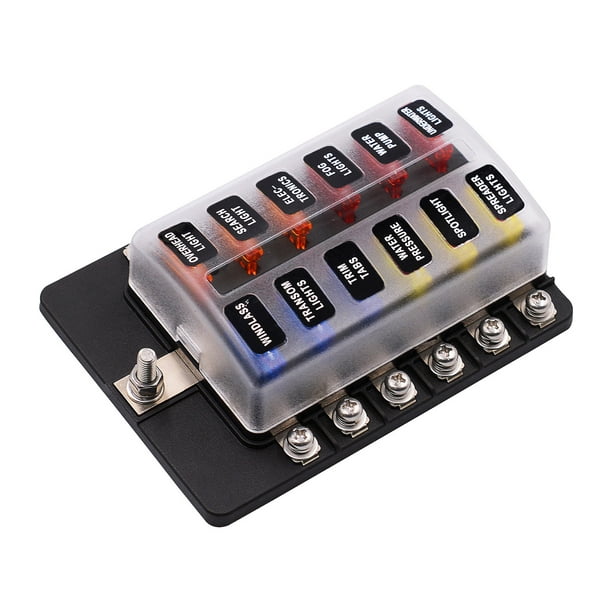Things about Blue Sea Fuse Block
Wiki Article
The 10-Minute Rule for Blue Sea Fuse Block
Table of Contents8 Simple Techniques For Blue Sea Fuse BlockThe Basic Principles Of Blue Sea Fuse Block More About Blue Sea Fuse BlockThe Blue Sea Fuse Block DiariesTop Guidelines Of Blue Sea Fuse BlockThe 15-Second Trick For Blue Sea Fuse Block
Fuses are bolted in position between the bus bar and also the second set of electrically isolated bolts. With this setup you can affix the boat's numerous high-current circuits, such as a windlass, bow thruster, high-output generator, the DC panel, etc, to the isolated screws. The various fuses are sized according to the current-carrying capacity of the conductors bolted to them.Some circuits will certainly still need to bypass the seclusion button so that they might be left on when the remainder of the watercraft is closed down. blue sea fuse block. These circuits generally consist of a bilge pump and also any type of billing tools (including photovoltaic panels, possibly a wind generator, as well as the inverter if it additionally increases as a battery charger).
This belongs to the circuit representation we developed for the complicated example watercraft in our Watercraft Electrics course. The devices connected to the fuse block in the top right are all bypassing the seclusion button S1. If you enroll in Watercraft Electrics 101, you will certainly learn how to check out such a layout and additionally how to make one for your own boat.
The Best Strategy To Use For Blue Sea Fuse Block

With DC circuits, the OCP is always placed in the favorable side of DC circuits. Note that some European boatbuilders install integrates and battery buttons in the DC negative side as well as on the positive side, however this is not advised other than in some isolated (drifting) ground DC systems.
This point may go to the battery, the battery button, the circulation panel, a subsidiary panel, some distribution bus bar, or other attaching factor. If the conductors in the new circuit are no smaller sized than the conductor that feeds the new circuit's point of connection, after that the OCP for the feeder conductor will completely protect the brand-new circuit - blue sea fuse block.
About Blue Sea Fuse Block
If the new circuit is not appropriately offered by overcurrent devices already in location, additional defense is required at its point of link, i. e., at its source of power. Positioning of fuses in the favorable conductor. Keep in mind exactly how a smaller sized fuse is made use of whenever a smaller sized conductor is connected, In some cases room restricts how close an OCP gadget can be put to the resource of power.If they have to be installed in battery areas, they discover here ought to be ignition secured.) The question then emerges, exactly how close is close enough? The common response, from the ABYC, is within 7" (17. 5cm). The ABYC enables the complying with, which have actually been tightened up in recent times: A conductor attached directly to a battery that is additionally "consisted of throughout its entire distance in a sheath or unit such as a channel, joint box, control box or enclosed panel" have to have its overcurrent defense "as close as achievable to the battery, but not to go beyond 72 inches (1 - blue sea fuse block.
Gone is the covering 72" allocation that made use of to be there. A conductor attached to a resource of power besides the battery (e. g., the battery switch, the circulation panel, or a few other point in the DC circuits) that is in a similar way contained in Go Here a sheath, and so on, must have its overcurrent security "as close as achievable to the factor of link to the resource of power, but not to go beyond 40 inches (1.
The 30-Second Trick For Blue Sea Fuse Block
Offered that alternators themselves are a resource of power, it has actually been debatable whether these included alternators required OCP at the alternator itself."Cranking-motor circuits are not called for to have overcurrent defense.In the marine field, where cranking circuits might be long, this method may produce a risk. If a car ignites, the passengers can pull over and leap out. If a boat ignites, it is not so straightforward. It makes no feeling to have any kind of unprotected circuits on a boat.
In winter, the inrush existing on a 12V starter motor might be as high as 1,500 amps; the cranking current may be as long as 200 amps. Typically, cranking conductors are undersized also for the cranking current, not to mention the inrush existing. This circumstance does not position a safety and security issue in itself, since these currents are received for just a few secs, so the conductors do not have time to get warm adequate to create a fire danger.
Some Known Incorrect Statements About Blue Sea Fuse Block
We made the training course with absolute novices in mind. As the electrical tons on boats increases, so also does the intricacy of electrical circuits as well as the potential for brief circuits as well as electric fires.
In the marine field, where cranking circuits may be long, this technique might develop a risk. If an automobile ignites, the occupants can draw over as well as leap out. If a watercraft ignites, it is not so straightforward. It makes no sense to have any vulnerable circuits on a watercraft.
Facts About Blue Sea Fuse Block Revealed

We made the training course with absolute novices in mind. As the electric load on watercrafts rises, so also does the complexity of electric circuits as well as the capacity for brief circuits and also electric fires.
Report this wiki page